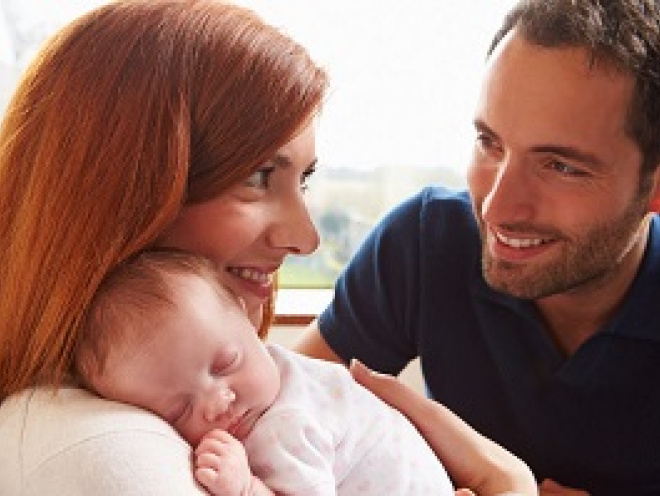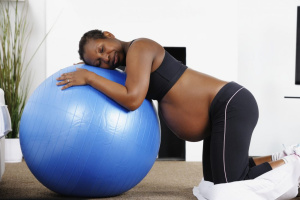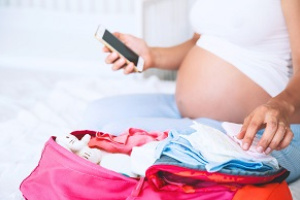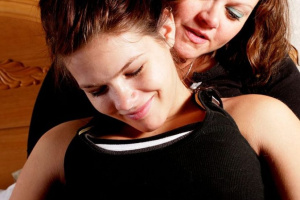You’ve probably been so busy you haven’t stopped to think what happens after your baby's born. Here’s an overview...
1. Third stage of labour
Immediately after you give birth, you'll be meeting and getting to know your baby. Your midwife will try not to disrupt this special time and will seek to minimise any separation from your baby while you bond.
For a little while after you give birth, the cord that runs between your baby and the placenta is still pulsating and providing them with iron rich blood. This usually stops after a few minutes when you may feel an urge to push the placenta out. This is known as the third stage of labour (Begley et al, 2015; NICE, 2017).
Some women prefer to have a ‘physiological’ third stage of labour. This means without drugs and where the cord isn’t clamped until after it’s stopped pulsating. This way, your baby still has all their blood from the placenta.
At other times, ‘active’ management is more appropriate. This means having an injection that encourages contractions so that your placenta comes away from the wall of your womb within 30 minutes. In that situation, the midwife will usually clamp and cut the cord within a few minutes of birth to avoid the drugs from the injection reaching your baby.
You can find out more in our article on the third stage of labour. You can discuss your options with your doctor or midwife, who will be able to support you with your decisions.
2. Vitamin K injections
You’ll be offered an injection of vitamin K for your baby (NHS Choices, 2016). This helps to prevent a rare bleeding disorder called Vitamin K Deficiency Bleeding. Your midwife will discuss this with you while you’re pregnant.
You can decide not to have vitamin K, or if you prefer your baby not to have an injection, they can have vitamin K by mouth instead (Puckett and Offringa, 2000; NHS Choices, 2016). Taking this option means your baby will need more doses (NHS Choices, 2016).
3. Skin-to-skin contact
After you've given birth your baby can be lifted straight onto your naked chest so that your skin is touching theirs. This is known as skin-to-skin contact and has many benefits for you and your baby (Moore et al, 2016, NICE 2017), including helping them keep calm, regulating their breathing, and helping with the initiation of breastfeeding (NHS, 2019).
As well as stimulating breastfeeding, it can help you give birth to your placenta. Skin-to-skin contact is a great thing for birth partners to do after the birth too, if you prefer.
4. Cleaning your baby
Don’t get a shock if your baby looks messy when they come out. They’ll have some of your blood on their skin and perhaps vernix – the greasy white substance that protects their skin in the womb.
They may be covered with a towel to dry them and help them stay warm while you have skin-to-skin contact, which may clean their skin a little. It's not necessary to remove any of this for the baby's health, in fact it's good for the baby's skin to keep it on.
5. Breathing
If your baby needs a bit of help to get their breathing established in the first few minutes, they might be taken to another part of the room to have some oxygen. Your baby will be brought back to you as soon as possible though (NHS Choices, 2016; NICE, 2017). If you are not sure about what is going on you can ask your midwife to explain.
6. Check over
A midwife will look over your baby immediately after they’re born to assess their wellbeing, and a full top-to-toe check of your baby will take place later on, usually within 72 hours of the birth. After the immediate post-birth assessment, midwives try to avoid separating you from your baby (NHS Choices, 2016; NICE, 2017).
7. Weighing and measuring
Ready for those all-important messages you’ll send announcing your baby’s birth weight, your newborn will be weighed and measured after an hour or so – there shouldn't be a rush to do this, as spending uninterrupted time with your baby straight after birth is more important. They’ll also be given a band with your name on to identify them (NHS Choices, 2016; NICE, 2017).
8. Your care
After birth, your temperature, pulse and blood pressure will be checked and the placenta and membranes examined to check they have all been expelled.
Your midwife will explain to you what needs to happen if you need to be examined to check for tears or grazes. They can provide gas and air for pain relief if needed, or a local anaesthetic. If you had small tears or grazes, your midwife might recommend leaving them to heal naturally without any stitches. Stitches can often be done by the midwife who looked after you during birth.
Some injuries may need to be managed in an operating theatre (NHS Choices, 2016).
9. Breastfeeding or bottle-feeding your baby
Your midwife will be there immediately after the birth to help you feed your baby, ideally within the first hour (NICE, 2017). They will support you with breastfeeding if that’s what you’d like to do, and can show you how to express your breastmilk if your baby is unable to feed straight away (NHS, 2019).
If you would like to feed your baby with formula, your midwife can show you how to make up a feed using the correct quantities of formula, how to sterilise bottles and how to store formula milk (RCM, 2014).
10. When can I go home?
If you’ve had an uncomplicated birth, and feel happy to do so, you could be home within a few hours.
However, if you need to stay overnight, you'll be transferred to a bed in the postnatal area (Which?, 2018). Your partner might be able to stay with you during the night on a chair too, but it's good to check beforehand.
Some hospitals and units also offer private rooms that you can pay to use if they are not being occupied by someone in greater need (Which?, 2018).
This page was last reviewed in August 2022.
Further information
Our support line offers practical and emotional support with feeding your baby and general enquiries for parents, members and volunteers: 0300 330 0700.
We also offer antenatal courses which are a great way to find out more about birth, labour and life with a new baby.
Make friends with other parents-to-be and new parents in your local area for support and friendship by seeing what NCT activities are happening nearby.
Begley CM, Gyte GM, Devane D, McGuire W, Weeks A. (2015) Active versus expectant management of women in the third stage of labour. Cochrane Database Syst Rev. (3):CD007412. Available from: https://www.ncbi.nlm.nih.gov/pubmed/25730178 [Accessed 3rd April 2021]
Cochrane. (2020) Cochrane Review: Early skin‐to‐skin contact for mothers and their healthy newborn infants. Available from: https://www.cochrane.org/news/cochrane-review-has-informed-20-sets-guidelines-around-world [Accessed 3rd April 2021].
Jordan S, Emery S, Watkins A, Evans J, Storey M, Morgan G. (2009) Associations of drugs routinely given in labour with breastfeeding at 48 hours: analysis of the Cardiff Births Survey. BJOG Available from: https://obgyn.onlinelibrary.wiley.com/doi/10.1111/j.1471-0528.2009.02256.x [Accessed 12th April 2021].
Moore ER, Bergman N, Anderson GC, Medley N. (2016) Early skin-to-skin contact for mothers and their healthy newborn infants. Cochrane Database Syst Rev. (11):CD003519. DOI: 10.1002/14651858.CD003519.pub4. Available from: http://cochranelibrary-wiley.com/doi/10.1002/14651858.CD003519.pub4/abstract [Accessed 3rd April 2021].
McNinch AW, Tripp JH. (1991) Haemorrhagic disease of the newborn in the British Isles: two year prospective study. BMJ. 303(6810):1105-1109. Available from: https://www.ncbi.nlm.nih.gov/pmc/articles/PMC1671305/ [Accessed 3rd April 2021].
NHS. (2019) Breastfeeding the first few days. Available from: https://www.nhs.uk/conditions/baby/breastfeeding-and-bottle-feeding/breastfeeding/the-first-few-days/ [Accessed 3rd April 2021].
NHS Choices. (2016) What Happens Straight After Birth. Available from: https://www.nhs.uk/conditions/pregnancy-and-baby/what-happens-straight-after-the-birth/ [Accessed 3rd April 2021].
NHS (2022) Early Days https://www.nhs.uk/pregnancy/labour-and-birth/after-the-birth/early-days/
NICE. (2017) Intrapartum Care for healthy women and babies. Available from: https://www.nice.org.uk/guidance/cg190/chapter/Recommendations#third-stage-of-labour [Accessed 3rd April 2021].
Puckett RM, Offringa M. (2000) Prophylactic vitamin K for vitamin K deficiency bleeding in neonates. Cochrane Database Syst Rev. 2000(4):CD002776. Available from : http://cochranelibrary-wiley.com/doi/10.1002/14651858.CD002776/full [Accessed 3rd April 2021].
RCM. (2014) Infant Feeding Supporting Parent Choice. Available from: https://www.rcm.org.uk/media/2355/pressure-points-infant-feeding.pdf {Accessed 3rd April 2021].
Which? (2018) Postnatal care, what happens after you’ve given birth. Available from: https://www.which.co.uk/birth-choice/choosing-where-to-give-birth/postnatal-care-what-happens-after-youve-given-birth. [Accessed 30th May 2018].








